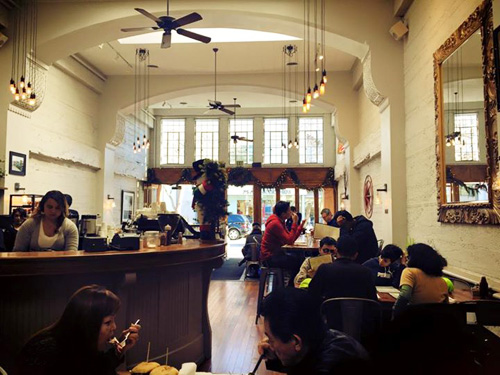
Palo Alto university cafe
PHOTO: Sylwia Gorajek, www.jaion.pl
Sipping coffee at a coffee shop in downtown Palo Alto, it’s not unusual to hear startup-related buzzwords permeating every conversation you happen to overhear. “Yeah, he’s looking for a Series A round, he already got some seed money to develop the prototype,” one says. “We’re developing a later-stage accelerator to help them scale,” said another. “So far some interesting ed-tech and clean-tech companies have applied.” This startup lingo might seem foreign in most places, but in Silicon Valley, it’s perfectly commonplace. And while most of these terms can be easily defined, what cannot is the magic of Silicon Valley itself.
On a map, Silicon Valley can be simply identified: it is generally thought to be the region around the western and southern shores of the San Francisco Bay; it encompasses the southern part of the Peninsula, all of Santa Clara Valley and southern portions of the East Bay. But more than a location, it’s a mentality. The mindset of being able to bring your ideas – no matter how far-fetched – to life. And it’s no coincidence that the magic happens here. This Palo Alto shop is just five minutes from Sand Hill Road where a large portion of VCs happen to be (that is, Venture Capital firms), and Stanford University, whose Computer Science department consistently produces some of the best and brightest minds in technology year after year.
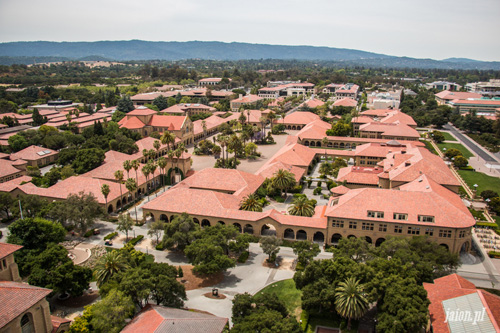
Stanford University
PHOTO: Sylwia Gorajek, www.jaion.pl
When did this modern day California Gold Rush start, and why Silicon Valley? One of the first significant moments in its history occurred in 1909 when Stanford University President David Starr Jordan invested $500 in Lee de Forest’s Audion, a vacuum tube which could amplify an electrical signal. Although ahead of its time, this early investment is often considered the first venture capital investment in Silicon Valley. However, the title of “Father of Silicon Valley” is widely considered to belong to Frederick Terman, a Stanford professor of electrical engineering. He encouraged his students to work for small local companies or to take risks and start their own companies rather than head east following graduation to join larger, “safe” corporations. In 1938 with support and guidance from Terman, William Hewlett and David Packard built a precision audio oscillator in a Palo Alto garage. This invention led to the formation of Hewlett-Packard in 1939. That garage would later be dubbed “the Birthplace of Silicon Valley”.
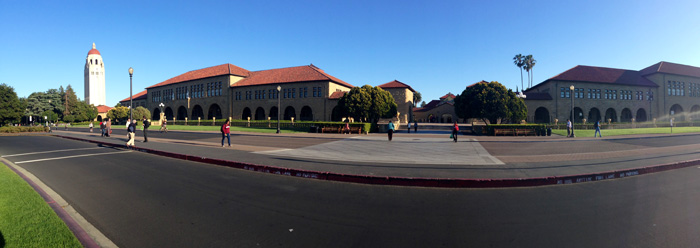
Stanford University and Hoover Tower
PHOTO: Dariusz Wodziak
In 1956, William Shockley moved to Mountain View to found Shockley Semiconductor Laboratory to improve silicon-based transistors in the midst of the Cold War and beginning of the space race. The following year, eight of Shockley’s employees – labeled the “Traitorous Eight” – formed their own company, Fairchild Semiconductor, which became a pioneer in manufacturing transistors and integrated circuits. In 1958, President Eisenhower established NASA and provided funding for the Ames Research Center in Mountain View, creating a link between government research and Silicon Valley.
In 1959 William Draper Jr., Frederick Anderson, and H. Rowan Gaither formed the first West Coast venture capital firm in Palo Alto. In 1968, two of the Traitorous Eight founded Intel, which created the world’s first commercially available microprocessor. By the 1970s, Silicon Valley was brimming with small but growing high-tech startups. The term Silicon Valley was coined in 1971 when Don Hoefler was writing about the semiconductor industry and the dense concentration of high-tech companies, many of which relied on silicon in their transistors. Since then, Silicon Valley has produced many of the world’s pioneers and leading tech companies.

Google HQ in Mountain View
PHOTO: Dariusz Wodziak
All of these companies, no matter how large, all started with merely an idea that then formed into a startup. The term “startup” is a loose and ever-evolving term, but generally speaking, it is a recently formed company with the capacity for exponential growth. It’s also the stage where the company is learning how to define itself and find its place in the market – often, this will lead to changes in the company mission or business model to best find its niche. The difference between a startup versus a small business is the capacity for exponential growth. The hair salon down the street might be able to open another salon or two in a short period of time, and grow their customer base, but a startup can gain millions of users in that same time span. Ultimately, what defines the end of a startup’s life span is what’s called “exiting”. That is, to either be acquired (bought out) by a larger company or become publicly traded via an IPO (Initial Public Offering). While many startups “fail” – and in Silicon Valley, failure is culturally embraced as a learning opportunity – exiting is the end goal. Companies like Google, Yahoo, and Facebook have gone public, while companies like Tumblr and Instagram have been acquired by Yahoo and Facebook, respectively.
In the startup life cycle, Angel investors and Venture Capitalists are critical players. The San Francisco Bay Area alone receives more than 55 percent of the country’s venture capital funding1. Angel investors primarily invest their own capital and tend to provide an early stage of funding. VCs manage money for institutions and tend to provide larger investments at a later stage. Both look out for people with ideas and technologies that can disrupt their market. In exchange for resources and capital, these investors acquire a portion of the business. As the startups grow, they will require increasingly larger rounds of financing (termed Series A, Series B, etc). Typically, for each subsequent round multiple investors combine their funds. With so much funding in the area, startups are exposed to many sources of funding and many investors willing to take a risk on the right idea or person.
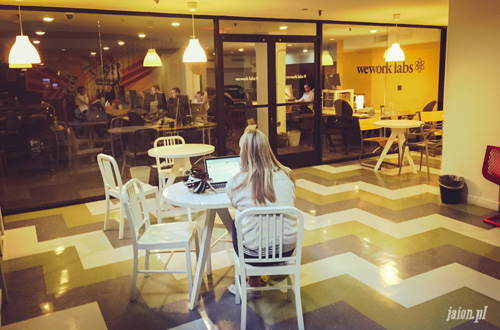
San Francisco coworking space
PHOTO: Sylwia Gorajek, www.jaion.pl
Once a startup has funding the team will typically move into a small office or rent desk space at one of the many co-working spaces around San Francisco or the Valley. Such co-working spaces offer all the necessary office amenities including conference rooms and copy machines as well as opportunities to bounce ideas off other like-minded individuals. Others choose to tap into the Silicon Valley’s rich network by applying for one of the entrepreneurial programs offered by incubators and accelerators. These startup hubs offer mentorship and resources such as office space and counseling (legal, financial). They also provide networking opportunities by organizing numerous events and inviting other successful entrepreneurs to speak. These hubs summarize precisely why this is such a great area — the concentrated wealth of resources and dedication to fostering entrepreneurship by those who have already become successful.
Silicon Valley attracts a large pool of highly skilled workers including engineers, researchers, software developers, and information technology specialists. Amongst the most desirable places to work are the now large tech companies like Facebook, Google or Apple that began as Silicon Valley startups and have established an innovative company culture. In their efforts to keep their employees happy and healthy, they often provide perks such as free meals, gym memberships, and private transportation for commuters.
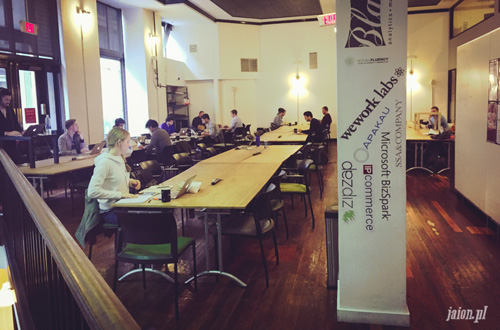
San Francisco coworking space
PHOTO: Sylwia Gorajek, www.jaion.pl
Despite the obvious benefits of living and working in Silicon Valley – not to mention its enviable weather year-round – what truly makes Silicon Valley unique is intangible; it’s more about the mindset. Only here will you experience such a “pay it forward” culture, which seems to drive the innovation and success. Here, it seems that most of the wealth is self-made. People owe their money and careers to hard work, persistence, and some good fortune. They are willing and eager to share their knowledge and expertise with others; many even invest their own wealth as Angels. People in Silicon Valley are more open-minded; they know the next great thing can come in any form. Resilience is a hallmark of the startup. These attitudes along with the great weather, diversity, and social tolerance make this the suburban paradise that is Silicon Valley. So while many startup founders continuously flock here with the goal of changing the world in some way, the amazing part about Silicon Valley is that many of them actually do.
CR

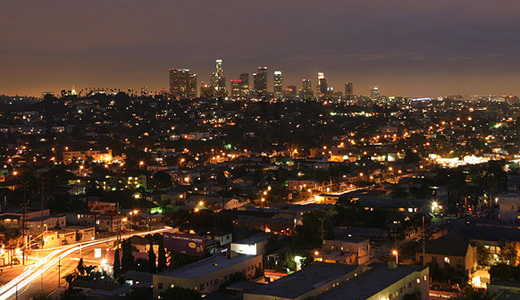
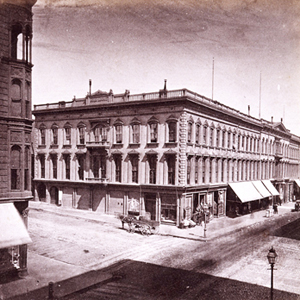


Pingback: Welcome to our Spring 2015 issue!
Pingback: Green Gate Consulting - Home